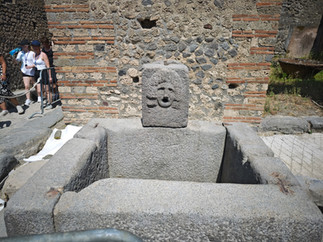Exploring the Lost City of Pompeii
- muse7699
- Aug 16
- 3 min read

I'm not one for spontaneity. I get anxious when I don't have a plan in place. So as a nomad I usually create a two-year vision board. I use repositioning cruises and group tours as my anchors and fill in the spaces. Usually within six - eight month, I firm up my plans, book accommodations and transportation. But during my planning for 2025 and 2026 I noticed a common theme. Exploration. From archeologists digging into a city lost in time, to visiting the last frontier, to traversing the ancient trade routes. I hope you join me on my summer 2025 - summer 2026 travels exploring ancient and natural wonders.
Pompeii - 73AD
Founded around 600BC, from Greek and Etruscan roots, Pompeii was more than just a city of 20,000 people. It was a haven for the noblest and wealthiest citizens of Rome. The city’s prime location, with its breathtaking views of the Bay of Naples, made it an ideal retreat for the Roman elite. The villas of featured lavish gardens, intricate frescoes, and expansive courtyards. They served as centers for social gatherings, intellectual conversation, and relaxation. Basalt stones lined the raised streets, remnants of aqueducts and plumbing underneath.

The city boasted a large amphitheater, capable of seating up to 20,000 spectators, where gladiatorial games and public spectacles captivated the masses. These events were integral to Pompeian culture, reflecting the city’s love for drama, excitement, and sport.

The city’s bathhouses were not merely places for bathing but were social epicenters. Here, the rich and powerful mingled, engaging in conversation while enjoying the warm waters. Pompeii’s bathhouses were architectural marvels, showcasing the Roman mastery of engineering and design. Taverns and brothels were also an integral part of the nightlife. Where information and favors were traded and procured.
Pompeii’s prosperity was linked to its role as a trade hub. The city’s port facilitated the influx of goods and ideas from across the Roman Empire. The blend of local resources and imported goods made Pompeii a bustling center of trade and commerce. Pompeii was particularly famous for its wine, Vesuvinum, which was a local specialty. The city’s fertile lands and favorable climate made it an ideal location for agriculture. The city also thrived as a center for cloth making and dyeing. These industries, alongside others such as metalworking, glassblowing, and pottery, contributed significantly to the city’s wealth. Daily Life in Ancient Pompeii: The Lifestyles of Rome's Elite - Pompeii Archaeological Park
Pompeii's commercial, religious and political center, the forum, stands at the intersection of two main roadways. Citizens gathered here to shop, do business and socialize. At the far end of the square lies the Temple of Jupiter. At the other end is the city hall and courthouse.
Pompeii 79AD

On August 24, 79AD. The citizens awoke to a normal day. Merchants opening their shops. Children playing in the street. But around mid-morning the first minor tremors began. This was normal for citizens living under the sleeping giant. And daily life continued. But the tremors grew in intensity. Based on archeological findings, the first major eruption of ash and smoke began around 12:00PM. Ashfall plunges the city into darkness. Pumice stones rain down on the street crushing buildings and people alike. People rush into homes where they are buried alive. By 4:00PM toxic gases engulf the streets of Pompeii. and by 5:00PM no signs of life. Aftershocks would persist over the next 24 hours, destroying the neighboring city of Herculaneum
"Darkness fell, not the dark of a moonless or cloudy night, but as if the lamp had been put out in a dark room," Pliny the Younger
The ruins at Pompeii were first discovered late in the 16th century. Excavation did not begin until 1748. Even after hundreds of years of work, about a third of the city still lies buried. New evidence shows that survivors, those that were able to flee the toxic gas and stones, quickly returned to Pompeii to resettle. Pompeii: Spectacular new discoveries unearthed include private spa
Visiting Pompeii was the highlight of my time in Italy. A thriving middle-class city where Roman and Greek, rich and working class co-existed. Worshipping variety of deities. Excavations continue today with unknown riches still to be unearthed. However, the sleeping giant is showing signs of re-awakening. The last major eruption of Vesuvius came in 1944, but since then, the region located around the volcano has experienced several major earthquakes, most recently in 1999 . It's not if but when Mt. Vesuvius will erupt and Italy is not prepared for this level of disaster.




































Comments